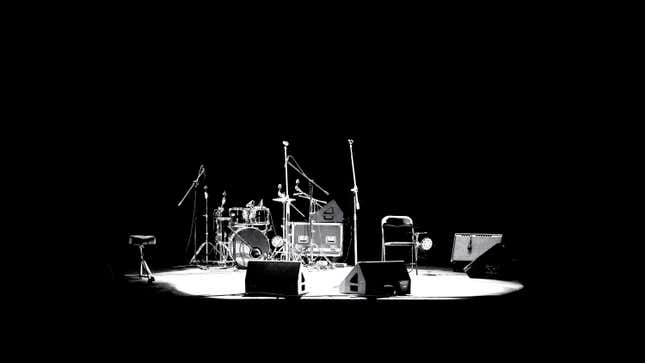
Illustration: Angelica Alzona/GMG (Photo: Shutterstock)
Twenty minutes before leaving Brooklyn, I had an existential crisis. This panic was uncharacteristically manageable, courtesy of the ease of desperation: I drank one more, I ripped off my weather-appropriate jumpsuit, opting for a faux-leather slip dress and torn fishnets reserved for singularly confident moments. I drank another, and ran to the train in my poseur garb, more anxious than invincible. It was Friday, March 13, and if things were going to get bad, I was going to become unfettered. One more night of live music, one more night of dancing like an agrestal weed in an apathetic New York City crowd. I went to a club I never frequent to see a Swedish band I’ll probably never see again, as they opened for groups I wish I never did. (Now, of course, I’d shell out untoward amounts to stand beneath the most unimaginative acts.) The Manhattan audience was exiguous, the sound guy spent most of the night bumming European cigarettes outside, a fellow carouser weaved between groups of friends and strangers, squeezing generous dollops of complimentary hand sanitizer into their palms, blissfully unaware that airborne transmission was the real concern. None of us knew. And it was a perfect final show: The moment live music exited stage left, and my year became private—communal no more.
Retroactively, describing March 13 feels necromantic—the dead before times, the supernatural who I was before who I am now—hell, the mythology of Friday the 13th isn’t lost. Many music obsessives like myself are in mourning, those whose lives have a soundtrack from the moment they wake to when they sleep, those who measure time with new releases from their favorite artists and recent discoveries, or when they’ll be able to see them perform, in the flesh. Contentment, not just happiness, can become contingent on that experience, depending on the level of commitment. (Or expertise, as I’ve rationalized it.) Once it became clear the country was going to shut down, and fears about the health of my loved ones and those most vulnerable gave way to more tactless thinking—I questioned how life could exist without live music, something I’d grown accustomed to experiencing three or four times a week, each week, for the last 11 years.
Most days are spent doing the solitary, time-consuming work of writing; live music was often the only place I’d communicate with others outside my bedroom or while running errands. Without concerts, my vocal cords rested, unexercised, to the point where I felt as though they could atrophy. (Stillness is so dramatic.) Without concerts, the only new voices I heard wafted inside from out of my window, muffled in masks. Over the last 10 months, I’ve learned to turn them into an audience for whatever record I put on. Strangers only sing to me now. When the sirens and protests came, my listening shifted—I turned to life-affirming hardcore and impassioned hip-hop to mask death, dreaming of being in that music’s crowd, sweat glistening. When the ambulances became less frequent, I returned to comfort: whimsical, perceptive indie-pop. But never live records—those were too painful.
-

-

-

-

-

-

-

-

-

-

-

-

-

-

-

-

-

-

-

-

-

-

-

-

-

-

-

-

-

-

-

-

-

-

-

-

-

-

-

-








































